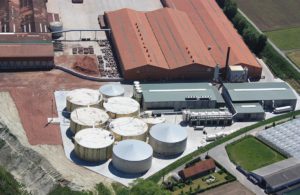AM-Power, Flanders, Belgium (Demonstration plant)

Read their factsheet, explore an illustration of the technology, process and products and watch the video – available in English and Flemish
Plant description: Am-Power (Pittem) is the largest biogas plant in Belgium and has a treatment capacity of 180,000 tonne. The plant treats biowaste originating from the intensive agro-industrial activities (non-manure), the farming sector (manure) and associated food industry (the manure is processed in a separate digestion line). Am-Power is located in the northern part of Belgium and this region is characterised by an excess of animal manure. Am-Power’s biobased fertilisers compete with disposal of manure which increases the price for product disposal in the region. Their major goal was to reduce the volume of the end-products which subsequently reduces costs for transport to regions in France with a demand for organic fertilisers.
Innovation: Am-power was already equipped with decanter centrifuge for solid/liquid separation of digestate and a band dryer converting the solid fraction into a fertiliser with 90% dry matter. Within SYSTEMIC, Am-Power has implemented a vacuum evaporator system to further reduce the volume of the liquid fraction. Condensed water of the evaporator can be discharged to surface water after post-treatment on a reverse osmosis (RO) installation.
Mass- and Energy balances: Am-Power’s biogas production amounts to 99 m3 biogas per tonne of feedstock. Biogas is converted into 32,166 MWh of electricity of which 85% is fed to the grid and the remainder used on-site. Thermal heat produced by the combined heat and power (CHP) generator is used on-site to meet the energy demand of the dryer and evaporators.
Digestate is separated into a solid and liquid fraction. After drying, 70 kg of dried solid fraction (95% DM) is produced per tonne of digestate. The evaporator effectively reduced the volume of the liquid fraction by 75% producing a concentrate and condensed water. The latter can be discharged to surface water after purification by means of an RO. Sulphuric acid is added prior to evaporation to keep ammonium in the concentrate of the evaporator hence producing a liquid organic NK- fertiliser.
End-products & Agronomic quality: The process produces a dried solid fraction with a high P content that can be used as a slow-release P fertiliser. The other fertilising product is an evaporated concentrate rich in nitrogen (9 g N/kg), potassium (10 g K/kg) and sulphur (12 g S/kg). Ammonium (NH4) makes up 85% of the present nitrogen, making the concentrate a suitable alternative for synthetic N fertiliser. Nevertheless, Am-Power’s experience is that local farmers have no interest in this product due to the high P content (1 g/kg), which counts for the P application rate limits, and due to farmers perception of the product as being similar to animal manure. However, there is a market for organic fertilisers in France, where Am-Power aims to sell blended end-products as an organic multi-nutrient fertiliser.
Environmental benefits: As compared to incineration of biowaste, Am-Power’s process has multiple advantages. First, fossil energy is being replaced by renewable electricity from biogas and secondly, the conversion of biowaste to organic fertilisers avoids losses of nitrogen and non-renewable phosphorus.
Business Case: Revenues from green electricity including subsidies form the core of Am-Power’s business case, whereas digestate handling and disposal is a cost item. Implementation of the NRR installation effectively reduces the volume of digestate-derived products but consumption of chemicals (sulphuric acid, anti-foam) on the evaporator is high. The high heat demand of the evaporator and dryer make this process only economically viable for AD plants that have access to large amounts of residual heat against low prices.
Outlook & Recommendations: Am-Power is now focussing on export of biobased fertilising products to France. The SYSTEMIC team advises them to develop fertilising products that comply with the new European Fertiliser Product Regulation though this may have consequences for their acceptance of feedstocks for the digester. Alternatively, they could consider promotion of their NK-rich concentrates in the nearby region by showing the agronomic efficiency of the product.

